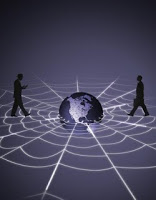 Kevin Samson
Kevin Samson
Activist Post
Now that government surveillance of the Internet and all communications has hit the mainstream, perhaps another dot can be connected to see where all of this is heading.
In early 2012 David Petraeus spoke to the CIA venture capital firm In-Q-Tel. He stated rather matter of factly that that an “internet of things” was already taking shape. It’s not only the elective consumer gadgets like smartphones and whatever new video game system is being introduced. No, how about your dishwasher? It’s all part of the arriving inter-connectivity of the Smart Grid.
Virtually any appliance you can think of will be part of an expanding network of Smart Homes tied directly into the Internet via low-powered computer chips. And, unlike computing via the traditional Internet where you can choose not to participate, there will be little chance at escaping . . . unless you are prepared to literally live in a cave.
Now, a new technology heralds an even simpler and more efficient way to ensure our connection to the Internet of Things.
The reality is that we are essentially bathed in background transmissions from our modern communications devices. These constant transmissions can be utilized as a built-in power source according to engineers at the University of Washington.
The devices of the future will be able to tap into these transmissions battery free. It’s called “ambient backscatter” and will create a “network out of thin air,” as described by University of Washington assistant professor, Joshua Smith:
“You can reflect these signals slightly to create a Morse code of communication between battery-free devices.”
Everyday objects could be enabled with battery-free tags to communicate with each other. A couch could use ambient backscatter to let the user know where his keys were left.
Smart sensors could be built and placed permanently inside nearly any structure, then set to communicate with each other. For example, sensors placed in a bridge could monitor the health of the concrete and steel, then send an alert if one of the sensors picks up a hairline crack. The technology can also be used for communication – text messages and emails, for example – in wearable devices, without requiring battery consumption. (Source)
Sounds like it’s all positive. However, researchers are excited precisely because “the applications are endless.” The Washington University press release concludes by announcing the source of funding:
The research was funded by the University of Washington through a Google Faculty Research Award and by the National Science Foundation’s Research Center for Sensorimotor Neural Engineering at the UW.
Let’s first keep in mind what already has been released about data security violations, privacy abuses, and identity theft surrounding corporations such as Google and look at this video showing some of the highlighted applications. See any concerns here?
This is nothing short of announcing the full-fledged arrival of Smart Cities with embedded, permanent monitoring of anything and anyone residing there, including a new phase of Google Wallet on steroids.
These smart cities are already cropping up in the UK (here and here) but are nowhere nearly as developed as what could potentially emerge from widespread use of this new technology.
With mega corporations like Google and IBM promoting the need for smart cities to encourage “sustainable growth,” the future is upon is. From IBM’s “Smarter Cities Page” we see the unabashed centrally planned experience:
Smarter cities of the future will drive sustainable economic growth. Their leaders have the tools to analyze data for better decisions, anticipate problems to resolve them proactively and coordinate resources to operate effectively.
As demands grow and budgets tighten, solutions also have to be smarter, and address the city as a whole. By collecting and analyzing the extensive data generated every second of every day, tools such as the IBM Intelligent Operations Center coordinate and share data in a single view creating the big picture for the decision makers and responders who support the smarter city.
The better the health of its citizens, the stronger a city’s economic vitality.Smarter Care uncovers valuable insights into lifestyle choices, social determinants and clinical factors, enabling holistic and individualized care to optimize outcomes and lower costs. (Source)
 If that doesn’t sound troubling enough, the fact that the second part of the funding for the “ambient backscatter” tech deals with “neural engineering.” Neural engineering is a relatively new field of study dealing specifically with brain-computer interface applications.
If that doesn’t sound troubling enough, the fact that the second part of the funding for the “ambient backscatter” tech deals with “neural engineering.” Neural engineering is a relatively new field of study dealing specifically with brain-computer interface applications.
Neural engineering is situated between and draws heavily from basic neuroscience on one hand and clinical neuroscience (neurology) on the other. The field of neural engineering encompasses experimental, computational, theoretical, clinical and applied aspects of research areas at the molecular, cellular and systems levels. (Source)
All combined, it would seem that the matrix is at once expanding and contracting, as technological evolution continues to move outward, while simultaneously limiting any individual choice to opt out.
For more information about the new smart economy, smart IDs, and the smart future being built please see Julie Beal’s must-read article Forget REAL ID — The Global Smart-ID is coming!, then read the rest of her deep research on her author page HERE and other resource links at her site which urges you to Get Mind Smart.
Main source:
http://www.washington.edu/news/2013/08/13/wireless-devices-go-battery-free-with-new-communication-technique/
Cisco infographic:
http://blogs.cisco.com/diversity/the-internet-of-things-infographic/
Read other articles by Kevin Samson Here
var linkwithin_site_id = 557381;
linkwithin_text=’Related Articles:’


Be the first to comment on "“Internet Of Things” One Step Closer With New Tech"